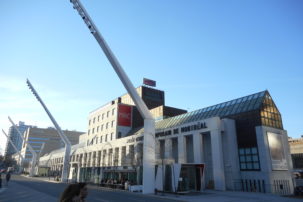Ever since “It’s Still Privileged Art,” a groundbreaking exhibition at the Art Gallery of Ontario in 1976 that marked their departure from the exclusive art world, Carole Condé and Karl Beveridge have developed a set of distinctive representational strategies and a particular way of working that reterritorializes the site of cultural production and reception. Oshawa: A History of Local 222 (1982–83)—a series of 56 photomontages that traces the history of one of Canada’s first major industrial unions, founded in 1937 in Oshawa—is an early example of the duo’s commitment to addressing labour conditions and struggles through the staging of workers’ voices. More than 35 years after it was made, the series was on view in its entirety at the Robert McLaughlin Gallery, alongside a new photomural made in collaboration with current Local 222 members. Working for and with the union, the artists created a timely response to General Motors’ decision to wind down production at its Oshawa Assembly Plant.
Chronologically arranged in five parts and conceptually framed by viewpoints shaped in the early 1980s, Oshawa: A History of Local 222 covers the history of the autoworkers union in Oshawa, from its founding in 1937 up to the beginning of the post-industrial era in the mid-1980s. The scenes recall issues that remain ongoing concerns, such as union organizing, class struggle and the gendered division of labour, while also foreseeing the technological shifts to come (in production and job stress), with a major focus on the changing role played by women in the workplace and union. Based on oral histories of the Local 222 Retirees Committee, as told to Condé and Beveridge over a two-year period, the series was staged as a highly stylized photo-narrative that combined sets, props, actors and photomontage, and was coded with visual hints of what art historian Dot Tuer has identified as “Brechtian theatricality, Soviet avant-garde photography and social-realist iconography,” as well as vintage advertising. The result was a nuanced viewing experience that could decorously fit in either a union hall or on a gallery wall.
Condé and Beveridge’s trademark style of recreating rather than documenting individual testimonies, by employing actors and using props, was a strategy first conceived to protect the workers they interviewed. In contrast, for Burial at Oshawa (Part 6) (2019), current members of Local 222 and union leadership play themselves. Commissioned by the Robert McLaughlin Gallery, Burial at Oshawa marks the closure of the GM plant in Oshawa, and documents—or more precisely, celebrates—the resistance to its closing. In Beveridge’s words, “The workers are still standing up to the corporate elite even if the plant is closing. In our present political moment, the fact that resistance takes place is something you need to celebrate even if it is not necessarily achieving the desired result.”
The work is a reimagining of 19th-century French painter Gustave Courbet’s A Burial at Ornans (1849–50). When Courbet presented the painting at the 1850 Paris Salon, it received both strong praise and criticism. Considered a history painting in scale but indeed a genre painting in subject, it’s an early attempt to bring the experience of rural life into the capital of France and into the most elite environment for the arts, to in effect heroicize the ordinary, heroicize common humanity. Condé and Beveridge’s Oshawa: A History of Local 222 received similarly mixed responses from the Toronto art world when it was first shown. Tuer points out that “The institutionalized nature of [Condé and Beveridge’s] artistic collaboration could lend itself to the production of ‘official’ images for the labour movement that [would] end up serving as a new cultural authority rather than as a grassroots mediation.” She continues, “Restaging the issue of class as a cultural as well as economic and social category, Condé and Beveridge perform a difficult balancing act between criticality and intentionality, running the risk of slipping into cultural prescription and a reification of working-class struggles.” Perhaps in this instance, the balancing trick is the distracted look the figures assume in Burial at Oshawa, another detail Condé and Beveridge borrowed from Courbet, to add a sense of ambiguity and contradiction to the narrative.

 Carole Condé and Karl Beveridge, Burial at Oshawa (Part 6), 2019. Digital print on vinyl, 1.5 x 3 m.
Carole Condé and Karl Beveridge, Burial at Oshawa (Part 6), 2019. Digital print on vinyl, 1.5 x 3 m.







